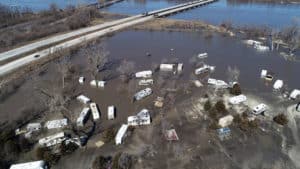
Credit: DroneBase/AP
Most of Nebraska is a disaster area with 95 percent of the state’s population affected by flooding. According to FEMA, total economic losses are approaching $1 billion, including more than $400 million to agriculture and more than $400 million to public infrastructure. Cascading levee failures along the Missouri River have meant that, for the time being, there’s essentially nothing holding back the floodwaters.
Six Nebraska public drinking water systems went offline, and dozens of wastewater treatment facilities failed — including one for Omaha which officials say could take weeks or months to restore. In several cases, raw sewage is being discharged into streams and rivers.
For rural residents who get their water from private wells, that added pollution could prove dangerous. Emergency room visits for gastrointestinal issues increase after heavy rains.
As climate change makes rainstorms more intense, this problem will only worsen. Across the Great Plains, the frequency of heavy downpours has increased by 29 percent over the past 60 years. Flooding isn’t just a quickly damaging natural disaster that destroys roads, bridges, homes, […]










